Karst Hydrological Connections of Lakes and Neoproterozoic Hydrogeological System between the Years 1985–2020, Lagoa Santa—Minas Gerais, Brazil
Abstract
:1. Introduction
2. Site Description
3. Materials and Methods
3.1. Climatological Survey
3.2. Identification of Lakes
3.3. Periodicity of the Lakes
3.4. Assessment of Hydrological Behavior
4. Results and Discussion
4.1. Historical Precipitation
4.2. Precipitation Cycles
4.3. Lake’s Identification and Periodicity
4.4. A Lake’s Water Behavior
4.5. Lake Classes of Hydrological Connection
4.5.1. Perennial Lakes—Analysis of Angular Coefficients
4.5.2. Perennial Lakes—Behavioral Analysis during Transition of Precipitation Cycles
4.5.3. Perennial Lakes—Compatibility between Analyses
4.5.4. Intermittent Lakes—Perimetric Variation
5. Conclusions
Author Contributions
Funding
Data Availability Statement
Acknowledgments
Conflicts of Interest
Appendix A
| Perennial Lakes | Trend Lines | Behavior after All Analyzed Years | ||||||||
|---|---|---|---|---|---|---|---|---|---|---|
| Dry (1985–1990) | Mixed (1990–1995) | Misto (1996–2001) | Dry (1985–1990) | Mixed (1990–1995) | Somatório de Todos Coeficientes Angulares | Dry (1985–1990) | Mixed (1990–1995) | Lagoas Que Diminuíram Menos de 5% | Dry (1985–1990) | |
| 1 | y = −4.8112x + 767.94 | y = 7x + 758.33 | y = 813.33 | y = −4.7678x + 835.29 | y = −3.2253x + 804.12 | y = −5.79 | 784 | x | ||
| 2 | y = −11.224x + 773.95 | y = −24.467x + 718.33 | y = 7.1x + 580.94 | y = 5.9556x + 593.59 | y = 18.231x + 584.77 | y = −4.39 | 669 | x | ||
| 3 | y = 0.979x + 318.64 | y = −2x + 335.56 | y = 0.5x + 330.83 | y = −0.5676x + 335.95 | y = −0.4396x + 332.31 | y = −1.52 | 328 | x | ||
| 5 | y = −30.927x + 718.94 | y = −2.1667x + 414.17 | y = 9.3706x + 370.76 | y = 3.7131x + 454.5 | y = −1.4286x + 551.54 | y = −21.42 | 493 | x | ||
| 6 | y = −34.213x + 1008.5 | y = 2.3333x + 660.78 | y = 16.157x + 578.89 | y = −1.9628x + 791.54 | y = 27.615x + 592.08 | y = 9.92 | 767 | x | ||
| 7 | y = −4.9266x + 897.77 | y = −19.5x + 904.17 | y = −0.2797x + 821.82 | y = −4.8194x + 783.01 | y = 30.148x + 519.96 | y = 0.64 | 777 | x | ||
| 8 | y = 76.759x + 1165.2 | y = −0.9667x + 2025.6 | y = −94.259x + 2988.7 | y = 0.3798x + 1957.1 | y = −5.6044x + 1992.5 | y = −23.69 | 1999 | x | ||
| 9 | y = −4.5559x + 367.03 | y = −0.05x + 383.81 | y = 9.8706x + 316.92 | y = −1.2663x + 346.97 | y = −2.2198x + 386.69 | y = 1.8 | 356 | x | ||
| 10 | y = 116.72x + 1340 | y = 21.483x + 1905.4 | y = −16.416x + 1228.1 | y = −9.6502x + 1043.5 | y = 5.0165x + 1115.1 | y = 117.15 | 1348 | x | ||
| 11 | y = −130.97x + 3593.5 | y = −7.55x + 2486.2 | y = 297.86x + 1193.1 | y = −111.64x + 3787.7 | y = −94.335x + 3046.2 | y = −46.63 | 2751 | x | ||
| 12 | y = −31.86x + 1221.8 | y = 34.8x + 809.11 | y = 29.738x + 649.45 | y = −10.837x + 1515.8 | y = 16.78x + 1357.9 | y = 38.62 | 1233 | x | x | |
| 13 | y = −90.633x + 2299.4 | y = −84.4x + 1739.9 | y = −6.8531x + 1382.2 | y = 22.118x + 1206.7 | y = −25.286x + 1776.5 | y = −184.78 | 1501 | x | ||
| 14 | y = −14.35x + 828.61 | y = −4.7833x + 736.69 | y = −4.8916x + 676.55 | y = −4.8328x + 590.19 | y = 1.978x + 566.54 | y = −26.88 | 639 | x | x | x |
| 15 | y = −32.727x + 1042.7 | y = −16.883x + 785.19 | y = 7.2727x + 636.06 | y = −2.87x + 968.1 | y = −17.319x + 848 | y = −62.51 | 781 | x | ||
| 16 | y = −3.3811x + 1028.4 | y = −24.333x + 1128.2 | y = −6.979x + 1171.7 | y = −8.4211x + 1026.7 | y = 6.5934x + 872.31 | y = −36.51 | 993 | x | ||
| 17 | y = 8.8112x + 1813.7 | y = 7x + 1912.7 | y = −5.2448x + 1990.1 | y = −14.747x + 2094.4 | y = 13.516x + 1854.1 | y = 9.34 | 1943 | x | ||
| 18 | y = −88.259x + 1597.3 | y = −46.683x + 1487.2 | y = 11.689x + 1325.6 | y = −31.451x + 1513.8 | y = −16.088x + 716.46 | y = −170.78 | 1137 | x | ||
| 19 | y = −12.657x + 523.94 | y = 11.133x + 452.44 | y = −17.063x + 674.24 | y = −2.3024x + 592.82 | y = −17.538x + 590.31 | y = −38.38 | 512 | x | ||
| 20 | y = −42.587x + 921.82 | y = −15x + 635 | y = −37.385x + 916 | y = −8.6357x + 670.48 | y = −7.9341x + 535.46 | y = −111.52 | 582 | x | ||
| 21 | y = −10.038x + 962.17 | y = −8x + 1053.3 | y = −15.105x + 1058.2 | y = −1.7337x + 916.47 | y = −8.6813x + 851.54 | y = −43.54 | 900 | x | ||
| 22 | y = 10.07x + 1825.5 | y = −6x + 1964.3 | y = −3.021x + 1922.6 | y = −8.1342x + 1969.7 | y = 10.582x + 1656.8 | y = 3.6 | 1867 | x | ||
| 23 | y = −3.5664x + 658.18 | y = −18x + 676.67 | y = 2.7273x + 627.27 | y = 8.7307x + 660.39 | y = −24.044x + 807.46 | y = −34.15 | 657 | x | ||
| 24 | y = −128.33x + 3915.2 | y = −50.5x + 3455.9 | y = −31.36x + 2322.8 | y = 11.547x + 2305.5 | y = −39.495x + 2613.5 | y= −238.14 | 2543 | x | ||
| 25 | y = −5.8322x + 1695.2 | y = 30.033x + 1696.9 | y = −20.381x + 2288.4 | y = −1.6925x + 2155.5 | y = 4.7967x + 1981.3 | y = 6.92 | 2018 | x | ||
| 26 | y = −8.3916x + 1064.5 | y = −41.167x + 1153.1 | y = −5.4545x + 955.45 | y = −2.1672x + 870.59 | y = 6.2857x + 812.08 | y = −50.88 | 909 | x | ||
| 27 | y = 9.3776x + 761.71 | y = −8x + 886.67 | y = −3.7762x + 844.55 | y = −1.4087x + 769.1 | y = 11.821x + 676.5 | y = 8.02 | 790 | x | ||
| 28 | y = −120.27x + 3929.5 | y = −75.967x + 3536.1 | y = −41.538x + 4003.5 | y = −5.4912x + 3892.3 | y = −121.65x + 4474 | y = −364.86 | 3569 | x | ||
| 29 | y = −59.451x + 1666.2 | y = −15.45x + 1142.9 | y = −9.8182x + 1335.8 | y = −12.114x + 1332.2 | y = 9.0989x + 1086.7 | y = −87.73 | 1217 | x | x | |
| 30 | y = 149.38x + 7126.9 | y = −246.7x + 9129.2 | y = −19.93x + 8566.5 | y = −13.167x + 8453.5 | y = 17.242x + 7661.1 | y = −113.17 | 8112 | x | ||
| 32 | y = 11.119x + 1763.7 | y = −4.9667x + 1912.3 | y = 11.346x + 1717.2 | y = 6.3158x + 1874.3 | y = −10.626x + 1800.8 | y = −13.18 | 1821 | x | ||
| 33 | y = 42.727x + 694.61 | y = 42.233x + 918.06 | y = −21.647x + 1247 | y = −8.8163x + 1109.9 | y = −9.1099x + 1021.3 | y = 45.4 | 1034 | x | ||
| 34 | y = 4.6434x + 1790.8 | y = 1874.3 | y = −21.818x + 2092.8 | y = −1.1146x + 1984.9 | y = −67.082x + 2066.7 | y = −85.36 | 1807 | x | ||
| 35 | y = 2.8147x + 2329.8 | y = −175.05x + 3936.5 | y = −138.74x + 4006.2 | y = −39.089x + 2999.4 | y = −218.05x + 3599.2 | y = −568.11 | 2529 | x | ||
| 36 | y = −47.916x + 3679.6 | y = 102.75x + 2912.6 | y = −37.182x + 3562.7 | y = 43.744x + 2801.7 | y = −4.4176x + 3381.3 | y = 56.99 | 3349 | x | ||
| 37 | y = 0.6294x + 787.58 | y = 6x + 776.67 | y = −7.1329x + 826.36 | y = −1.4087x + 769.1 | y = −14.835x + 786.92 | y= −16.64 | 777 | x | ||
| 38 | y = −4.542x + 853.77 | y = 5x + 721.67 | y = −23.497x + 902.73 | y = −3.0341x + 745.49 | y = 3.4176x + 669 | y = −22.65 | 757 | x | ||
| 39 | y = 0.4545x + 2353.9 | y = −5x + 2499.3 | y = −0.4196x + 2433.7 | y = −16.221x + 2547.7 | y = −41.538x + 2530.2 | y = −62.71 | 2370 | x | ||
| 40 | y = −28.986x + 1121.7 | y = −22.333x + 789.44 | y = −14.021x + 878.64 | y = −17.666x + 923.71 | y = −5.0549x + 763.85 | y = −88.04 | 795 | x | ||
| 41 | y = −8.3217x + 427.92 | y = −0.7167x + 341.47 | y = −2.5769x + 339.33 | y = −5.7245x + 391.44 | y = 8.2198x + 240.69 | y = −9.11 | 332 | x | ||
| 42 | y = −11.979x + 559.53 | y = 40.133x + 308.44 | y = −18.745x + 537.92 | y = −3.4675x + 439.27 | y = 2.6978x + 411.58 | y = 8.65 | 444 | x | ||
References
- Feathers, J.; Kipnis, R.; Pilóp, L.; Arroyo-Kalin, M.; Coblentz, D. How old is Luzia? Luminescence dating and stratigraphic integrity at Lapa Vermelha, Lagoa Santa, Brazil. Geoarchaeology 2010, 25, 395–436. [Google Scholar] [CrossRef]
- Kohler, H.C. Geomorfologia Cárstica na Região de Lagoa Santa-M.G. Ph.D. Thesis, FFLCH-USP, São Paulo, Brazil, 1989; 113p. [Google Scholar]
- Ford, D.C.; Williams, P.W. Karst Geomorphology and Hydrology, 2nd ed.; John Wiley & Sons: Chichester, UK, 2007; 562p. [Google Scholar]
- Auler, A. Hydrogeological and Hydrochemical Characterization of the Matozinhos—Pedro Leopoldo Karst, Brazil. Master’s Thesis, Western Kentucky University, Bowling Green, KY, USA, 1994; 110p. [Google Scholar]
- Berbert-Born, M.L.C. Carste de Lagoa Santa—Berço da paleontologia e da espeleologia brasileira. In Sítios Geológicos e Paleontológicos do Brasil; Schobbenhaus, C., Campos, D.A., Queiroz, E.T., Winge, M., Berbert-born, M.L.C., Eds.; DNPM/CPRM—Comissão Brasileira de Sítios Geológicos e Paleobiológicos (SIGEP): Brasília, Brazil, 2002; Volume 1, pp. 415–430. [Google Scholar]
- Pessoa, P.F.P. Hidrogeologia do Aquífero Cárstico Coberto de Lagoa Santa, MG. Ph.D. Thesis, Universidade Federal de Minas Gerais, Belo Horizonte, Brazil, 2005; 375p. [Google Scholar]
- Galvão, P.; Halihan, T.; Hirata, R. Evaluating karst geotechnical risk in the urbanized area of Sete Lagoas, Minas Gerais, Brazil. Hydrogeol. J. 2015, 23, 1499–1513. [Google Scholar] [CrossRef]
- Galvão, P.; Halihan, T.; Hirata, R. The karst permeability scale effect of Sete Lagoas, MG, Brazil. J. Hydrol. 2015, 532, 149–162. [Google Scholar] [CrossRef]
- Galvão, P.; Hirata, R.; Cordeiro, A.; Osório, D.B.; Peñaranda, J. Geologic conceptual model of the municipality of Sete Lagoas (MG, Brazil) and the surroundings. An. Acad. Bras. Ciências 2016, 88, 35–53. [Google Scholar] [CrossRef]
- Galvão, P.; Hirata, R.; Halihan, T.; Terada, R. Recharge sources and hydrochemical evolution of an urban karst aquifer, Sete Lagoas, MG, Brazil. Environ. Earth Sci. 2017, 76, 159. [Google Scholar] [CrossRef]
- De Paula, R.S. Modelo Conceitual de Fluxo dos Aquíferos Pelíticoscarbonáticos da Região da APA Carste de Lagoa Santa, MG. Ph.D. Thesis, Instituto de Geociências, Universidade Federal de Minas Gerais, Belo Horizonte, Brazil, 2019. [Google Scholar]
- De Paula, R.S.; Velásquez, L.N.M. Method to complete flow rate data in automatic fluviometric stations in the karst system of Lagoa Santa area, MG, Brazil. Braz. J. Geol. 2020, 50, e20190031. [Google Scholar] [CrossRef]
- De Paula, R.S.; Teixeira, G.M.; Ribeiro, C.G.; Silva, P.H.P.; Silva, T.G.A.; Vieira, L.C.M.; Velásquez, L.N.M. Parâmetros Hidrodinâmicos do Aquífero Cárstico-Fissural da Região de Lagoa Santa, Minas Gerais. Rev. Água Subterrânea 2020, 34, 221–235. [Google Scholar] [CrossRef]
- Velásquez, L.N.M.; Andrade, I.B.; Ribeiro, C.G.; Amaral, D.G.P.; Viera, L.C.M.; Cardoso, F.A.; De Paula, R.S.; Silva, P.H.P.; Souza, R.T.; Almeira, S.B.S. Projeto de Adequação e Implantação de Uma Rede de Monitoramento de Águas Subterrâneas em Áreas com Cavidades Cársticas da Bacia do Rio São Francisco Aplicado à Área Piloto da APA Carste de Lagoa Santa, Minas Gerais. Relatório Parcial, PROCESSO FUNDEP/GERDAU/UFMG n22.317/Plano de Ação Nacional para a Conservação do Patrimônio Espeleológico nas Áreas Cársticas da Bacia do São Francisco. Pan Cavernas do São Francisco. 2018. Available online: https://www.gov.br/icmbio/pt-br/assuntos/biodiversidade/pan/pan-cavernas-do-sao-francisco (accessed on 1 March 2022).
- Peñaranda Salgado, J.R. Condicionamento Estrutural e Litológico da Porosidade Cárstica da Formação Sete Lagoas, Município de Sete Lagoas (MG). Ph. D. Thesis, Universidade de São Paulo, São Paulo, Brazil, 2016. [Google Scholar]
- Piló, L.B. Geomorfologia Cárstica. Rev. Bras. De Geomorfol. 2000, 1, 88–102. [Google Scholar] [CrossRef]
- Assunção, P.H.d.S. Análise da Zona de Recarga e sua Interação com o Aquífero Cárstico na Lagoa do Matadouro, Zona Urbana de Sete Lagoas: Uma Abordagem Científica e Ambiental. Bachelor’s Thesis, Universidade Federal de Ouro Preto, Ouro Preto, Brazil, 2019. [Google Scholar]
- Alves, M.; Galvão, P.; Aranha, P. Karst hydrogeological controls and anthropic effects in an urban lake. J. Hydrol. 2021, 593, 125830. [Google Scholar] [CrossRef]
- Macedo, C.A.R.; Alvarez, G.C. O Desaparecimento da Lagoa do Sumidouro: Análise do Comportamento Hidrogeológico da Lagoa ao Longo dos Últimos 40 Anos. Bachelor’s Thesis, Instituto de Geociências (IGC), Universidade Federal de Minas Gerais (UFMG), Belo Horizonte, Brazil, 2021. [Google Scholar]
- Kohler, H.C.; Coutard, J.P.; De Queiroz-Neto, J.P. Excursão a Região Kárstica ao Norte de Belo Horizonte. In Colóquio Interdisciplinar Franco-Brasileiro: Estudo e Cartografação de Formações Superficiais e Suas Aplicações em Regiões Tropicais; (Guia de excursões); USP: São Paulo, Brazil, 1978; Volume II, pp. 20–43. [Google Scholar]
- Ribeiro, J.H.; Tuller, M.P.; Filho, A.D.; Padilha, A.V.; Córdoba, C.V. Projeto VIDA: Mapeamento Geológico, Região de Sete Lagoas, Pedro Leopoldo, Matozinhos, Lagoa Santa, Vespasiano, Capim Branco, Prudente de Morais, Confins e Funilândia, Minas Gerais—Relatório Final, Escala 1:50.000, 2nd ed.; Mapas e Anexos (Série Programa Informações Básicas para Gestão Territorial—GATE, Versão Digital e Convenção); CPRM: Belo Horizonte, Brazil, 2003; 54p. [Google Scholar]
- Pacheco Neto, W.M.; Meira, G.T.; Pena, M.A.C.; Silva, P.H.P.; Uhlein, G.J.; Velásquez, L.N.M.; De Paula, R.S. Avaliação da conectividade hidráulica entre os aquíferos cársticos na região APA Carste de Lagoa Santa e suas imediações, MG. Revista Estudos Geológicos—UFPE, 20 December 2023. [Google Scholar]
- Alkmim, F.F.; Martins-Neto, M.A. A bacia intracratônica do São Francisco: Arcabouço estrutural e cenários evolutivos. In A Bacia do São Francisco Geologia e Recursos Naturais; Pinto, C.P., Martins-Neto, M.A., Eds.; SBG: Belo Horizonte, Brazil, 2001; pp. 9–30. [Google Scholar]
- Dardenne, M.A. Síntese sobre a estratigrafia do Grupo Bambuí no Brasil Central. In Proceedings of the 30 Congresso Brasileiro de Geologia, Recife, Brazil; 1978; Volume 2, pp. 597–610. [Google Scholar]
- Zalán, P.V.; Romeiro-Silva, P.C. Bacia do São Francisco. Bol. Geociências Petrobrás 2007, 15, 561–571. [Google Scholar]
- Noce, C.M.; Teixeira, W.; Machado, N. Geoquímica dos gnaisses TTG e granitoides neoarqueanos do Complexo Belo Horizonte, Quadrilátero Ferrífero, Minas Gerais. Rev. Bras. Geociência 1997, 27, 25–32. [Google Scholar] [CrossRef]
- Ribeiro, C.G.; Meireles, C.G.; Lopes, N.H.B.; Arcos, R.E.C. Levantamento Geológico Estrutural Aplicado aos Fluxos dos Aquíferos Cárstico-Fissurais da Região da APA Carste de Lagoa Santa, Minas Gerais. Bachelor’s Thesis, Instituto de Geociências, Universidade Federal de Minas Gerais, Belo Horizonte, Brazil, 2016; 157p. [Google Scholar]
- Teixeira, G.M.; Pena, M.A.C.; Silva, P.H.P. Avaliação da Conectividade Hidrogeológica Entre a Região a Sudeste de Sete Lagoas e a APA Carste de Lagoa Santa. MG. Bachelor’s Thesis, Instituto de Geociências da Universidade Federal de Minas Gerais, Belo Horizonte, Brazil, 2020. [Google Scholar]
- Teodoro, M.I.P.; Velásquez, L.N.M.; Fleming, P.M.; De Paula, R.S.; Souza, R.T.; Doi, B.M. Hidrodinâmica do Sistema Aquífero Cárstico Bambuí, com uso de traçadores corantes, na região de Lagoa Santa, Minas Gerais. Águas Subterrâneas 2019, 33, 392–406. [Google Scholar] [CrossRef]
- Ribeiro, C.G.; Velásquez, L.N.M.; De Paula, R.S.; Meireles, C.G.; LOPES, N.H.B.; Arcos, R.E.C.; Amaral, D.G.P. Análise dos Fluxos Nos Aquíferos Cárstico-Fissurais da Região da APA Carste de Lagoa Santa, MG; Universidade Federal de Minas Gerais: Belo Horizonte, MG, Brazil, 2019. [Google Scholar]
- Dantas, J.C.M.; Velásquez, L.N.M.; De Paula, R.S. Horizontal and vertical compartmentalization in the fissure and karstic aquifers of the Lagoa Santa Karst Environmental Protection Area and surroundings, Minas Gerais, Brazil. J. South Am. Earth Sci. 2023, 123, 104219. [Google Scholar] [CrossRef]
- Pessoa, P.F.P.; Mourão, M.A.A. Levantamento hidrogeológico. In APA Carste de Lagoa Santa—Meio Físico; IBAMA/CPRM: Belo Horizonte, Brazil, 1998; p. 36. [Google Scholar]
- De Paula, R.S.; Velásquez, L.N.M. Balanço hídrico em sistema hidrogeológico cárstico, região de Lagoa Santa, Minas Gerais. Rev. Água Subterrânea 2019, 33, 119–133. [Google Scholar] [CrossRef]
- Berbert-Born, M.L.C. Geoquímica dos Sedimentos Superficiais da Região Cárstica de Sete Lagoas-Lagoa Santa (MG), e os Indícios de Interferências Antrópicas. Master’s Thesis, Department of Geology, Universidade Federal de Ouro Preto, , Ouro Preto, Brazil, 1998. [Google Scholar]
- Pacheco Neto, W.M.; De Paula, R.S.; Velásquez, L.N.M.; Meira, G.; Pena, M.A.C. Characterization and classification of lakes based on geospatial analyses in the karst hydrogeological system of the Bambuí group, Lagoa Santa, Minas Gerais, Brazil. J. South Am. Earth Sci. 2023, 132, 104662. [Google Scholar] [CrossRef]
- Meneses, I.C.R.R.C. Análise Geossistêmica na Área de Proteção Ambiental (APA) Carste de Lagoa Santa, MG. Master’s Thesis, Pontifical Catholic University of Minas Gerais, Belo Horizonte, Brazil, 2003; 187p. [Google Scholar]
- GRASS PROJECT. Geographic Ressource Analysis Support System. 2013. Available online: http://grass.osgeo.org.com (accessed on 1 July 2021).
- Yamamoto, J.K.; Landim, P.M.B. Geoestatística: Conceitos e Aplicações; Oficina de Textos: São Paulo, Brazil, 2015; 215p. [Google Scholar]
- Starcy, J.R.; Hardison, C. Double-Mass Curves; Geological Water Supply Paper; United States Geological Survey: Reston, VA, USA, 1996; Volume 1541-B. [Google Scholar]
- Tucci, C.E.M. Hidrologia: Ciência e Aplicação, 2nd ed.; Editora da UFRGS/ABRH: Porto Alegre, Brazil, 2001; 943p. [Google Scholar]
- Thiessen, A.H. Precipitation averages for large areas. Mon. Weather. Rev. 1911, 39, 1082–1089. [Google Scholar] [CrossRef]
- Pettitt, A.N. A non-parametric approach to the change point problem. J. Appl. Stat. 1979, 8, 126–135. [Google Scholar] [CrossRef]
- Mann, H.B. Nonparametric tests against trend. Econometrica 1945, 13, 245–259. [Google Scholar] [CrossRef]
- Kendall, M.G. Rank Correlation Methods; Charles Griffin: London, UK, 1975; 272p. [Google Scholar]
- Bartels, R.J.; Black, A.W.; Keim, B.D. Trends in precipitation days in the United Stades. Int. J. Climatol. 2019, 40, 1038–1048. [Google Scholar] [CrossRef]
- Magalhães, M.N.; De Lima, A.C.P. Noções de Probabilidade e Estatística; Editora da Universidade de São Paulo: São Paulo, Brazil, 2002; Volume 5. [Google Scholar]
- USGS—United States Geological Survey. 2021. Landsat Data Continuity Mission. U.S. Department of the Interior, U.S. Geological Survey. 2012–3066. Available online: https://earthexplorer.usgs.gov/ (accessed on 2 November 2021).
- Meneses, P.R.; Almeida, T. Introdução ao Processamento de Imagens de Sensoriamento Remoto. Universidade de Brasília, Brasília, Brazil. 2012, pp. 121–160. Available online: https://edisciplinas.usp.br/pluginfile.php/5550408/mod_resource/content/3/LivroSensoriamentoRemoto.pdf (accessed on 22 May 2023).
- Andrade, A.C.; Francisco, C.N.; Almeida, C.M. Desempenho de Classificadores Paramétrico e Não Paramétrico na Classificação da Fisionomia Vegetal. Rev. Bras. Cartogr. 2014, 66, 349–363. [Google Scholar] [CrossRef]
- Amaral, D.G.P. Análise do Comportamento e Desempenho Hídrico das Depressões Cársticas da Região da APA Carste Lagoa Santa (MG). Master’s Thesis, Universidade Federal de Minas Gerais, Belo Horizonte, Brazil, 2018. [Google Scholar]
- Tavares, I.C.P. Caracterização Hidrológica da Bacia do Córrego Samambaia, Região da APA Carste de Lagoa Santa—MG. Master’s Thesis, Instituto de Geociências, Universidade Federal de Minas Gerais, Belo Horizonte, Brazil, 2020. [Google Scholar]
- Legrand, H.E.; Llamoreaux, P.E. Hydrogeology and hydrology of karst. In Hydrogeology of Karstic Terrains; Burger, A., Dubertret, L., Eds.; IAH: Paris, France, 1975. [Google Scholar]
- Pizani, F.M.C.; Pereira, M.P.R.; Da Silva, M.M.; Elmiro, M.A.T. Técnicas de sensoriamento remoto para análise temporal do espelho d’água da Lagoa Grande na cidade de Sete Lagoas–MG. Rev. GEOgrafias 2021, 17, 81–102. [Google Scholar] [CrossRef]
- Likens, G.E. (Ed.) Lake Ecosystem Ecology: A Global Perspective; Academic Press: Cambridge, MA, USA, 2010. [Google Scholar]
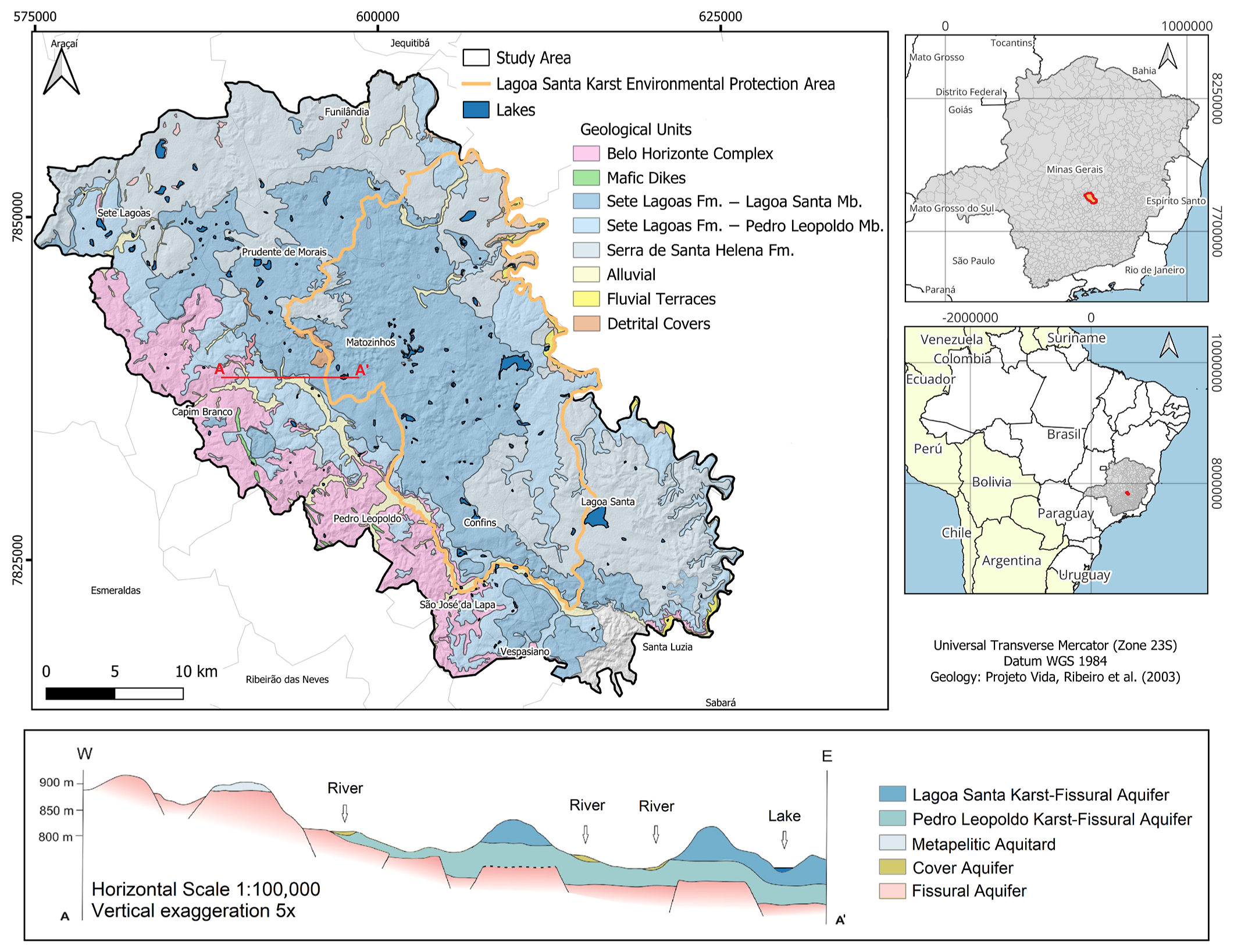
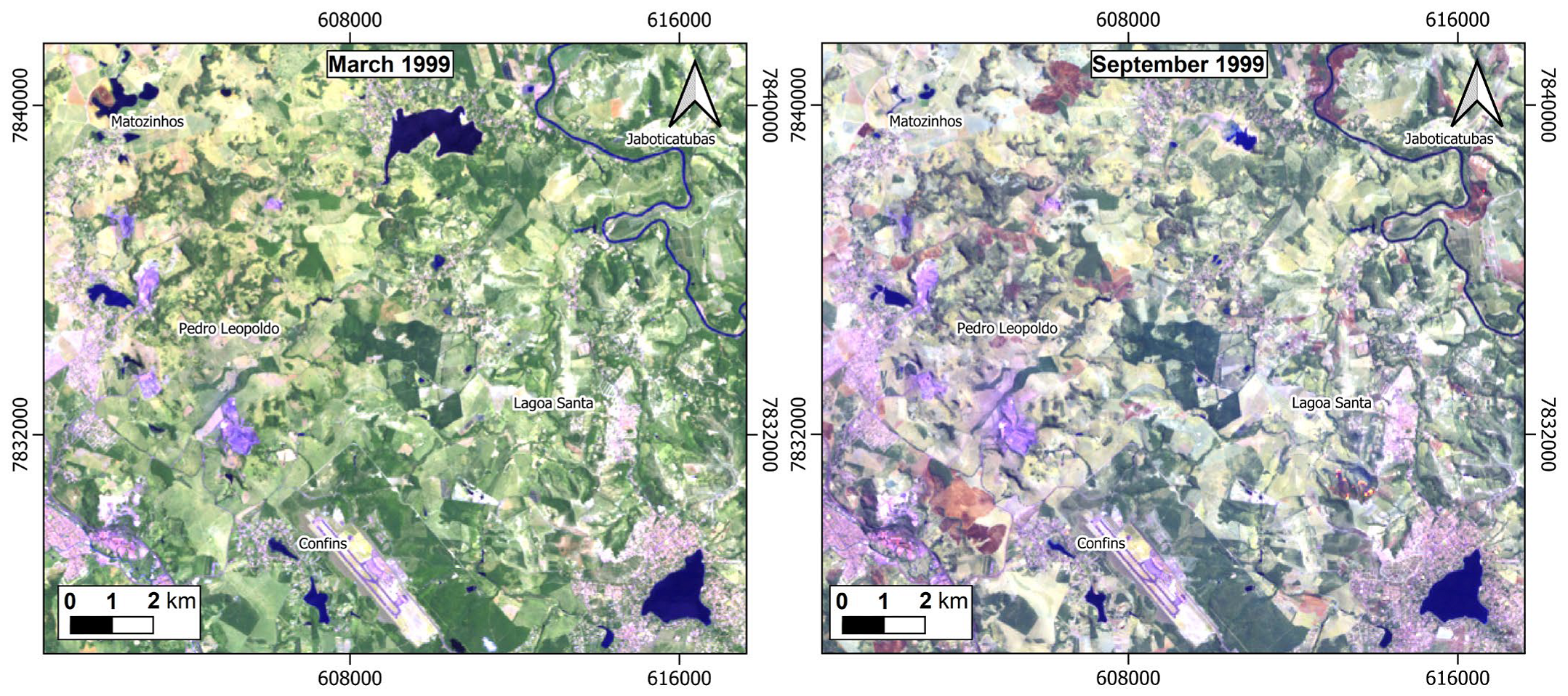
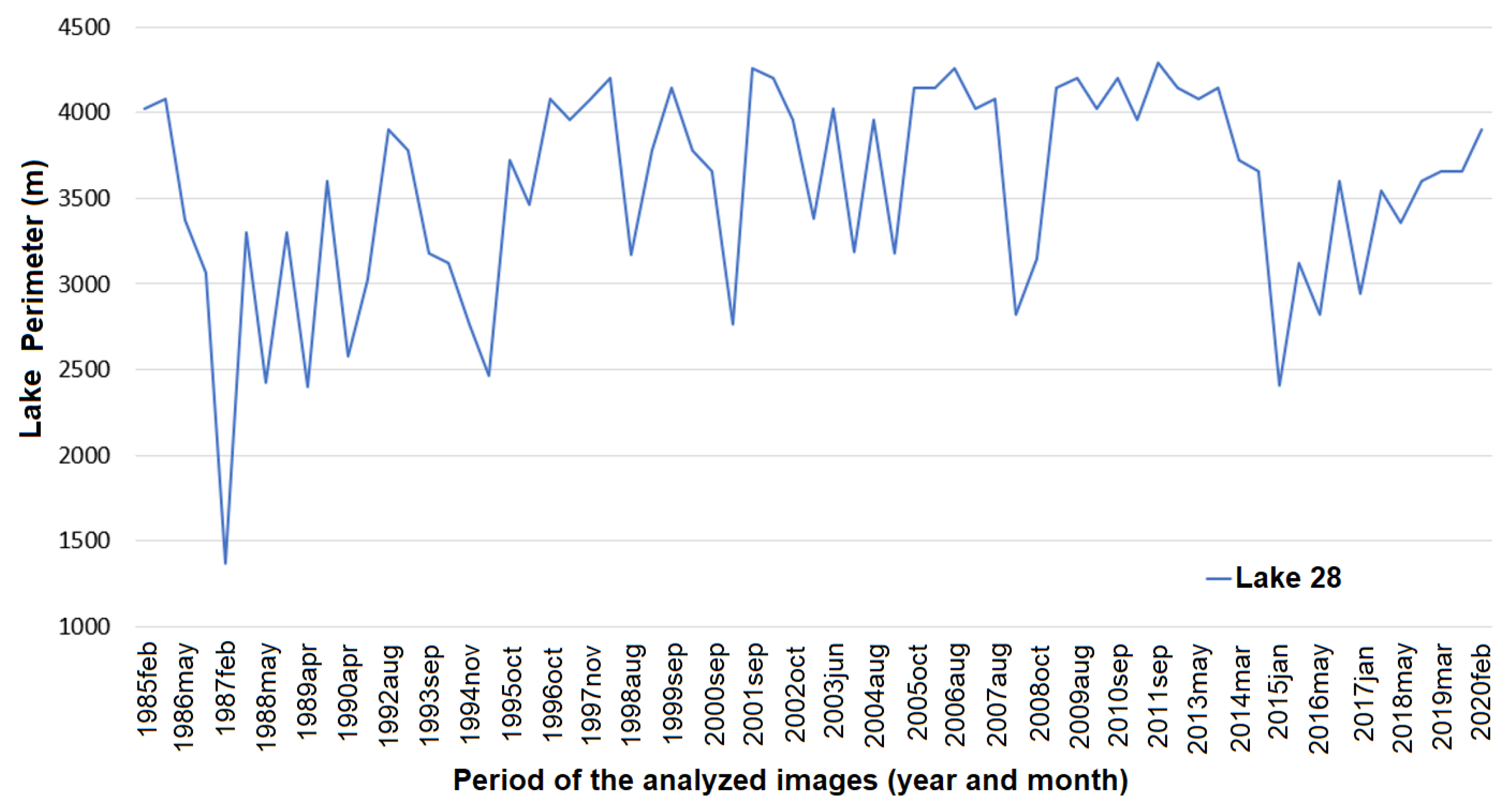
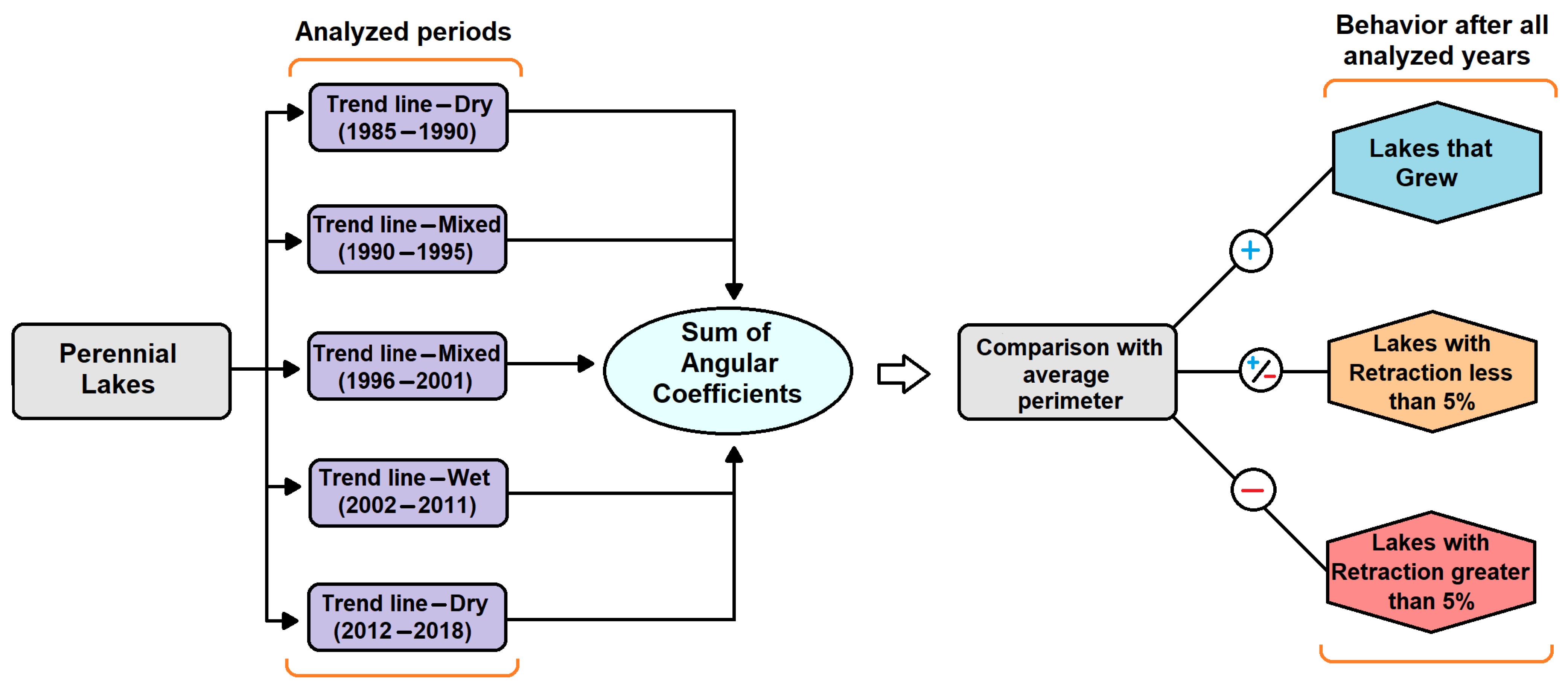
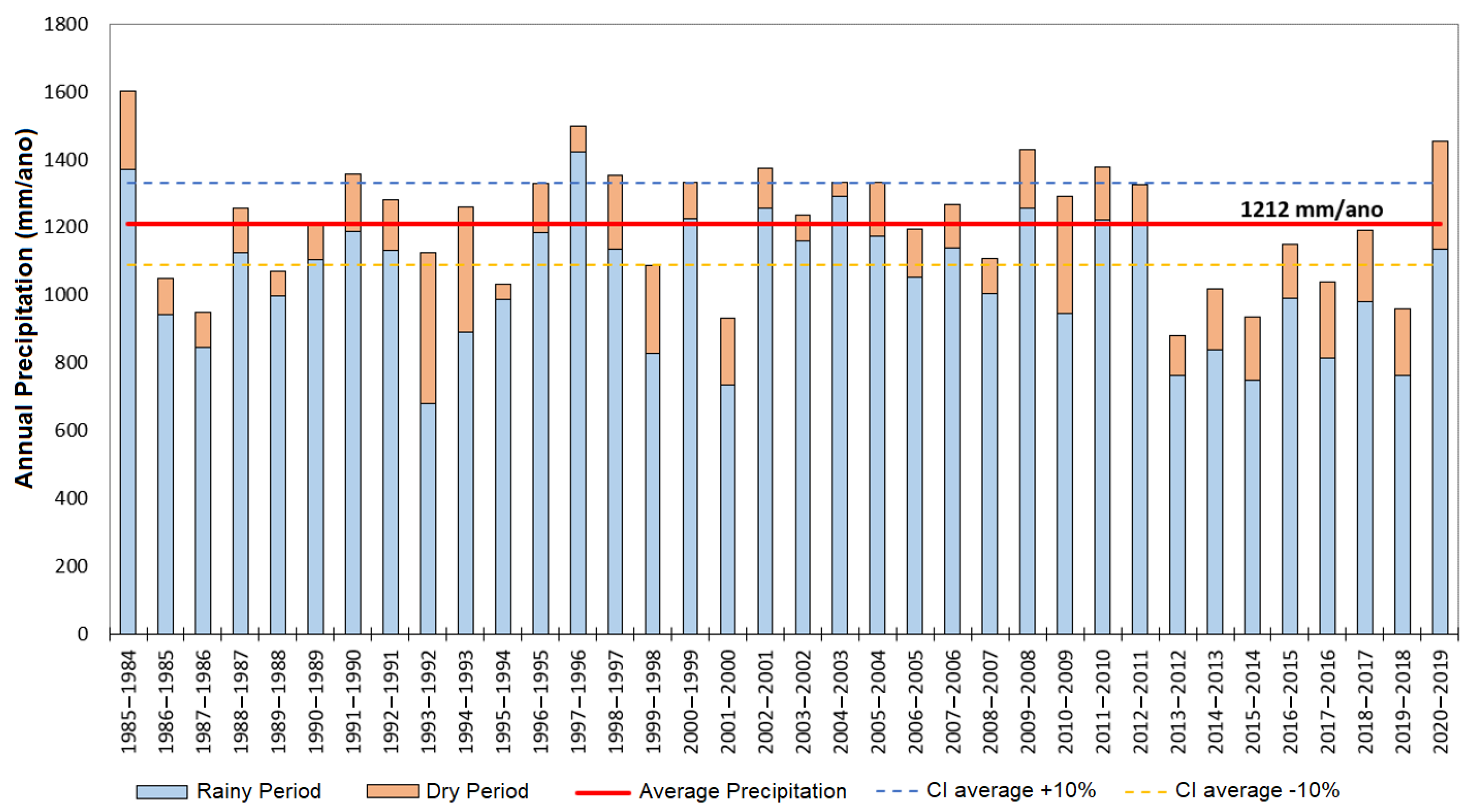

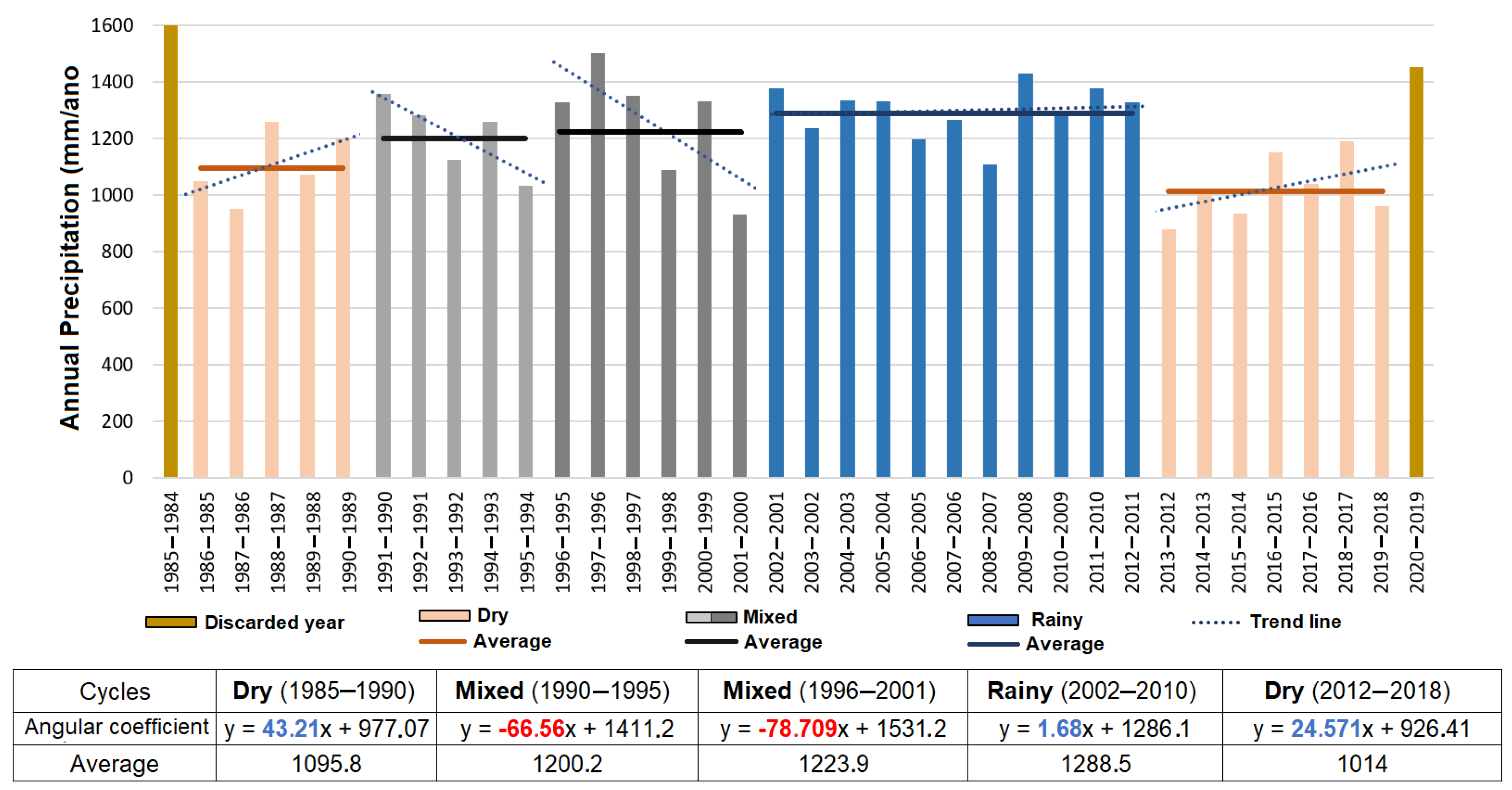
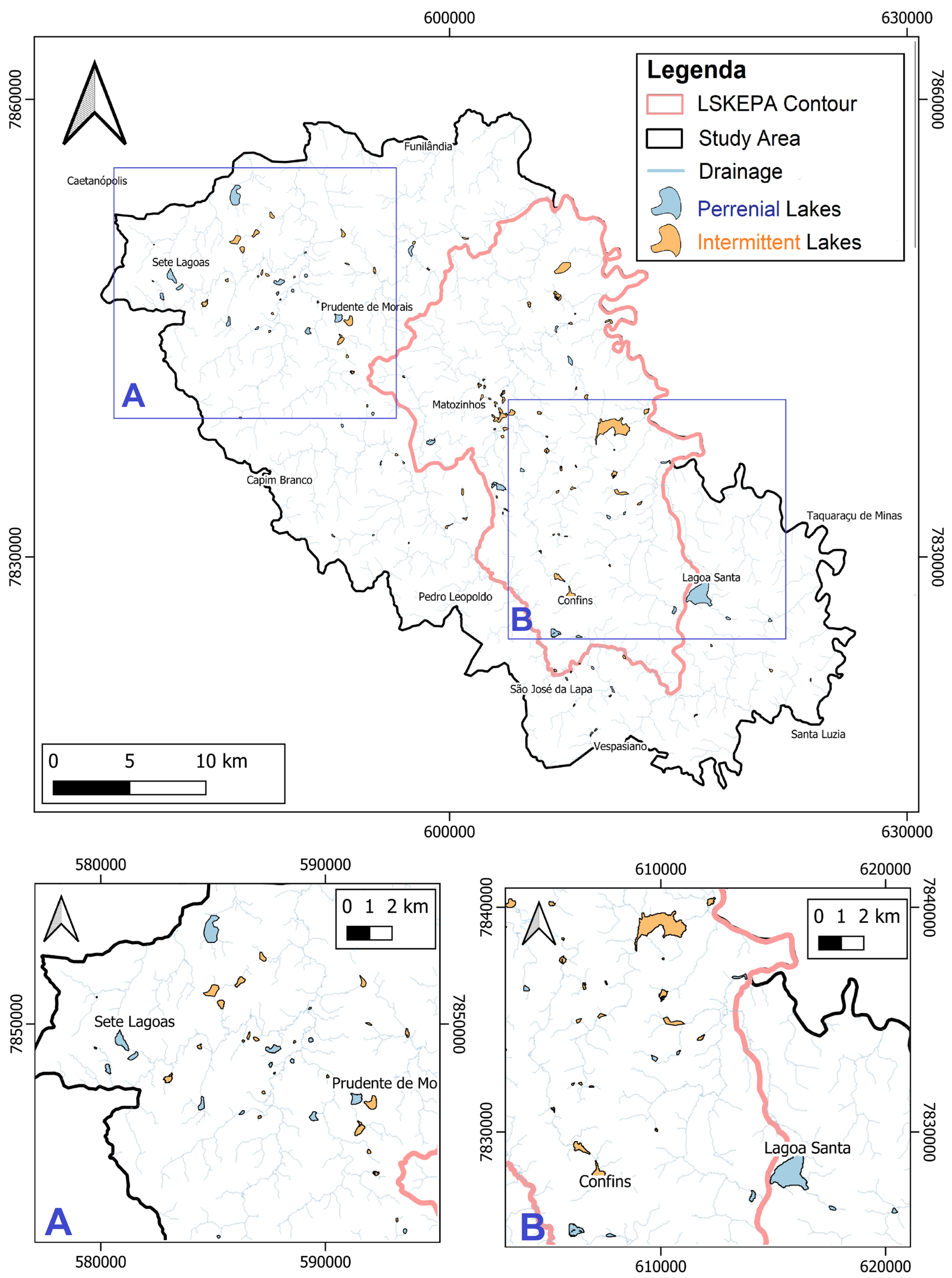
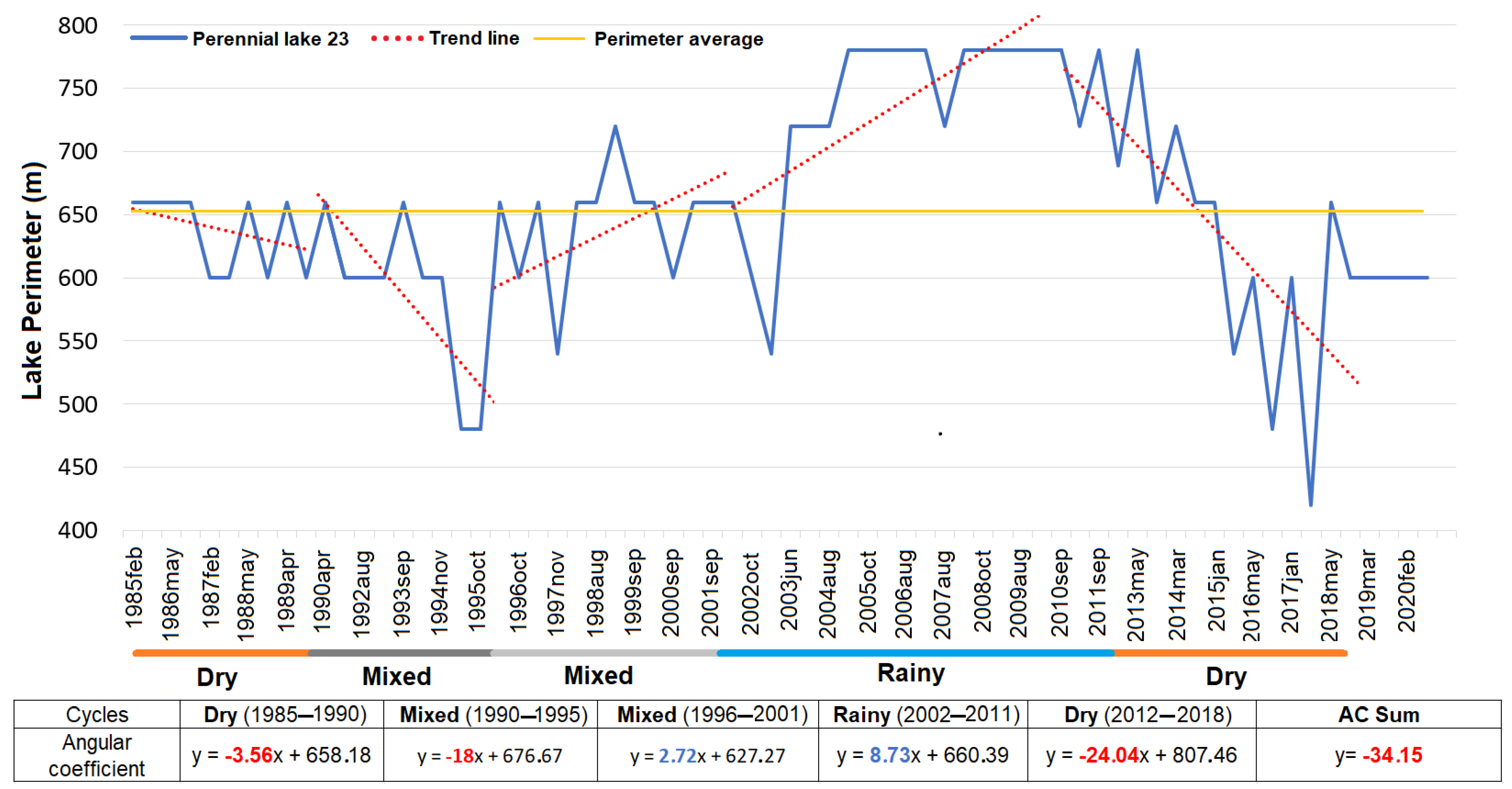
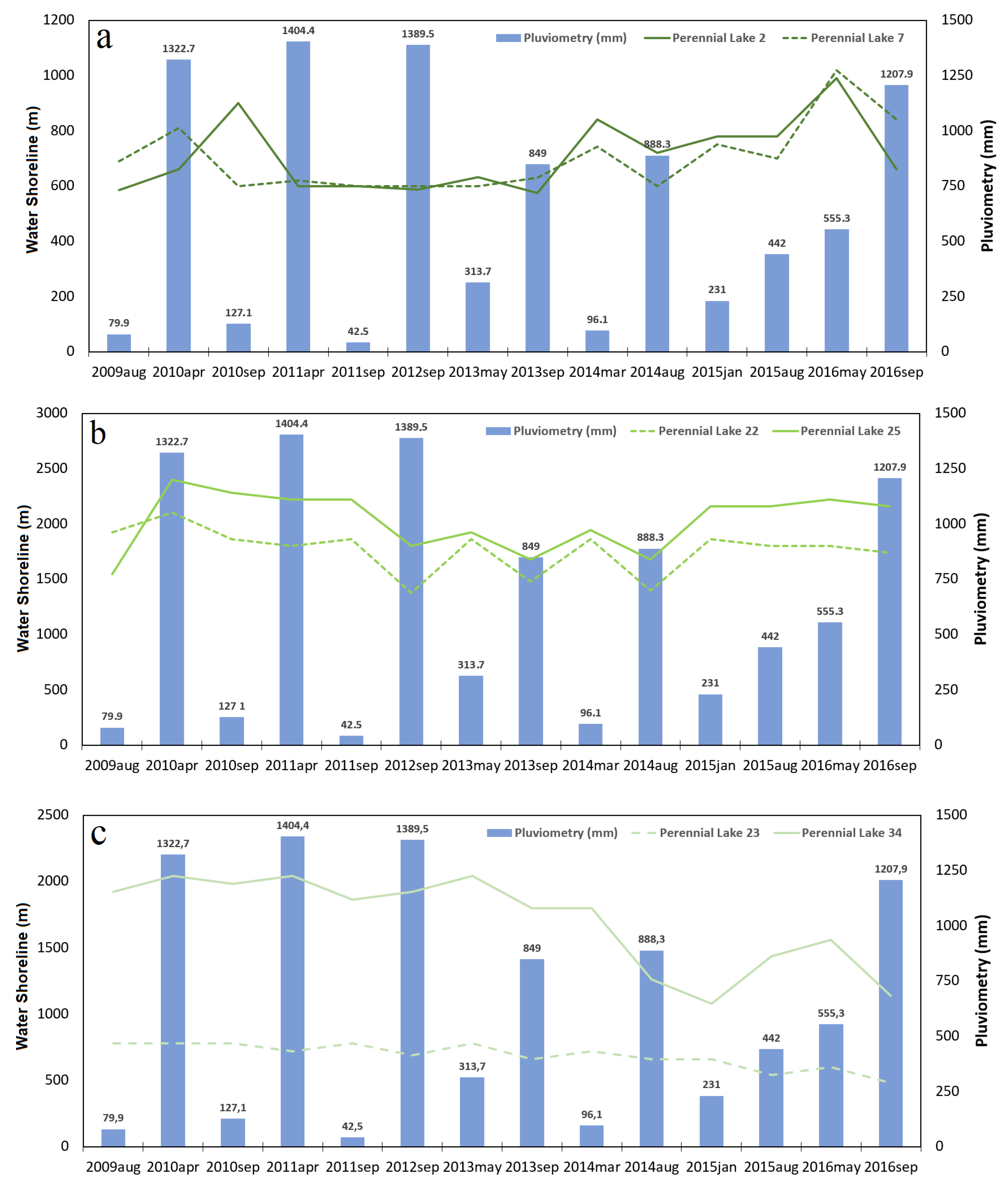
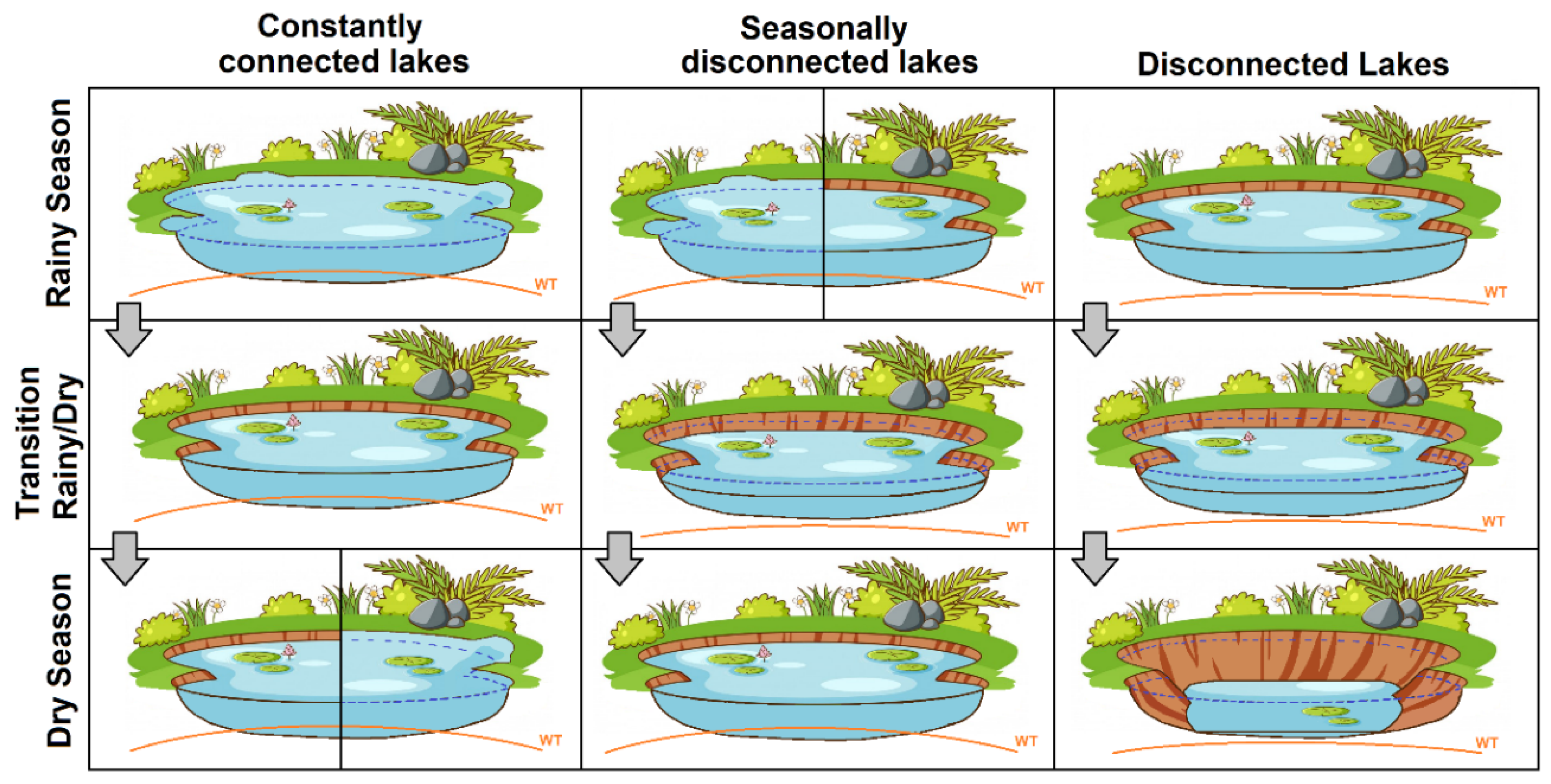

| Method | Parameter | Precipitation |
|---|---|---|
| Pettitt’s test | K | 124 |
| t | 28 | |
| p-value (two-tailed) alpha | 0.39 0.05 | |
| Interpretation a | Accept H0 | |
| Mann–Kendall trend test | Kendall’s tau | −0.06 |
| S | −38 | |
| Var(S) | 5390 | |
| p-value (two-tailed) | 0.61 | |
| alpha | 0.05 | |
| Interpretation b | Accept H0 |
| Perennial Lakes | Trend Lines | Behavior after All Analyzed Years | ||||||||
|---|---|---|---|---|---|---|---|---|---|---|
| Dry (1985–1990) | Mixed (1990–1995) | Mixed (1996–2001) | Rainy (2002–2010) | Dry (2012–2018) | Sum of Angular Coefficients | Lakes Perimeter (m) | Lakes That Enlarged | Lakes with Retraction Less than 5% | Lakes with Retraction Greater than 5% | |
| 1 | y = −4.8112x + 767.94 | y = 7x + 758.33 | y = 813.33 | y = −4.7678x + 835.29 | y = −3.2253x + 804.12 | −5.79x | 784 | x | ||
| 6 | y = −34.213x + 1008.5 | y = 2.333x + 660.78 | y = 16.157x + 578.89 | y = −1.9628x + 791.54 | y = 27.615x + 592.08 | 9.92x | 767 | x | ||
| 8 | y = 76.759x + 1165.2 | y = −0.966x + 2025.6 | y = −94.259x + 2988.7 | y = 0.3798x + 1957.1 | y = −5.6044x + 1992.5 | −23.69x | 1999 | x | ||
| 10 | y = 116.72x + 1340 | y = 21.483x + 1905.4 | y = −16.416x + 1228.1 | y = −9.6502x + 1043.5 | y = 5.0165x + 1115.1 | 117.15x | 1348 | x | ||
| 13 | y = −90.633x + 2299.4 | y = −84.4x + 1739.9 | y = −6.8531x + 1382.2 | y = 22.118x + 1206.7 | y = −25.286x + 1776.5 | −184.78x | 1501 | x | ||
| 20 | y = −42.587x + 921.82 | y = −15x + 635 | y = −37.385x + 916 | y = −8.6357x + 670.48 | y = −7.9341x + 535.46 | −111.52x | 582 | x | ||
| 35 | y = 2.8147x + 2329.8 | y = −175.05x + 3936.5 | y = −138.74x + 4006.2 | y = −39.089x + 2999.4 | y = −218.05x + 3599.2 | −568.11x | 2529 | x | ||
| 36 | y = −47.916x + 3679.6 | y = 102.75x + 2912.6 | y = −37.182x + 3562.7 | y = 43.744x + 2801.7 | y = −4.4176x + 3381.3 | 56.99x | 3349 | x | ||
Disclaimer/Publisher’s Note: The statements, opinions and data contained in all publications are solely those of the individual author(s) and contributor(s) and not of MDPI and/or the editor(s). MDPI and/or the editor(s) disclaim responsibility for any injury to people or property resulting from any ideas, methods, instructions or products referred to in the content. |
© 2024 by the authors. Licensee MDPI, Basel, Switzerland. This article is an open access article distributed under the terms and conditions of the Creative Commons Attribution (CC BY) license (https://creativecommons.org/licenses/by/4.0/).
Share and Cite
Pacheco Neto, W.; de Paula, R.; Galvão, P. Karst Hydrological Connections of Lakes and Neoproterozoic Hydrogeological System between the Years 1985–2020, Lagoa Santa—Minas Gerais, Brazil. Water 2024, 16, 2591. https://doi.org/10.3390/w16182591
Pacheco Neto W, de Paula R, Galvão P. Karst Hydrological Connections of Lakes and Neoproterozoic Hydrogeological System between the Years 1985–2020, Lagoa Santa—Minas Gerais, Brazil. Water. 2024; 16(18):2591. https://doi.org/10.3390/w16182591
Chicago/Turabian StylePacheco Neto, Wallace, Rodrigo de Paula, and Paulo Galvão. 2024. "Karst Hydrological Connections of Lakes and Neoproterozoic Hydrogeological System between the Years 1985–2020, Lagoa Santa—Minas Gerais, Brazil" Water 16, no. 18: 2591. https://doi.org/10.3390/w16182591








